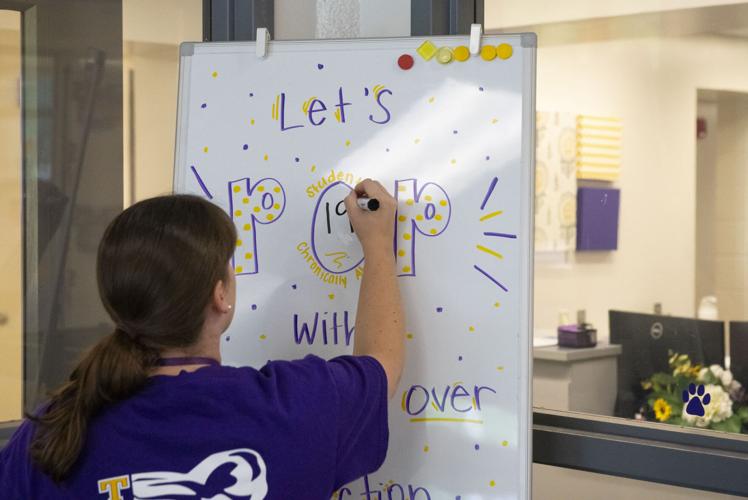Simply being at school leads to better student performance and education.
At least that's the case in Elmore County and Tallassee schools where administrators and teachers have been working for the last few years to battle chronic absenteeism and truancy. Elmore County and Tallassee City schools have seen more than 20% of students classified as chronically absent meaning they had missed 18 school days or more. That is 10% of the school year. Elmore County Schools superintendent Richard Dennis likens it to adults missing parts of a movie.
“You don't get there on time and then you decide you need to go stand in line to buy drinks and popcorn,” Dennis said. “You get the big, huge drink and the popcorn. Finally, you get in the theater, the movie is going. Of course, the drink is huge and then you have to go to the bathroom.”
Dennis said movie goers then miss significant portions by being tardy and in the middle by being absent. It’s easy to miss 15 to 20 minutes of a two hour movie.
“If you weren't there the whole time, you're going to miss those elements of the movie that perhaps are crucial to understand what took place,” Dennis said.
Dennis suggested those who were absent would not do well at recounting or comprehending what happened in the movie. He said it is very similar in schools. He saw it play out as a principal at Holtville, Wetumpka and Prattville high schools.
“The students who were absent on a regular basis were the ones who were on the failure list at the end of the school year,” Dennis said. “It's not rocket science. If you're there and engaged, you're going to be successful and pass.”
Chronic absenteeism includes both excused and unexcused absences. Truancy deals with the unexcused absences and Alabama law allows the courts to step in with seven or more unexcused absences through the compulsory attendance law.

Cliff Williams / TPI Elmore County District Court Judge Ben Baxley, right, speaks about how the juvenile courts have been used to improve truancy in the county.
Elmore County District Court Judge Ben Baxley has been on the bench for about a year. He has been a prosecutor in federal and state courts. Most recently he was with the Alabama Attorney General’s Office. He has seen how a lack of education increases a person’s odds of being involved in criminal activity. His wife Nacole has been a teacher for her entire career and shared with him the need for something to be done.
Baxley reached out to Elmore County and Tallassee City schools to start an early warning truancy program.
“Parents are invited to court to discuss their child’s absences at five unexcused absences,” Baxley said. “Previously parents were not invited until the seventh unexcused absence when it was then illegal in the state.”
Parents are given the information surrounding state law and allowed to connect with agencies that aid in helping both parents and students succeed in school and life.
The program was executed with the help of administrators at both Elmore County and Tallassee City schools, juvenile probation officers and the Elmore County Commission.
In the last school year, nearly 2,200 students and their parents came before Baxley as part of the early warning program. At the same time administrators and the courts held parents accountable for their child’s school attendance.
In Elmore County Schools, truancy petitions increased from 30 in the 2023-2024 school year to 126 in the 2024 school year. Parental responsibility warrants went from zero to 16. Of those, four parents were sentenced to time in jail for their children being truant.
Baxley shared the story of one such parent and student who turned things around in just one year. The student and parent were in Baxley’s courtroom in July 2024.
“It wasn't their first rodeo system for being placed on probation for not complying with the compulsory attendance law,” Baxley said.
The mother spent time in the Elmore County Jail. Baxley had juvenile court probation officers monitor the situation. When August and the start of school came, the student was in school to begin the school year. By the end of September, the student still hadn’t missed a day.
“Before that hearing in July, she had missed so many days the previous year she had been held back a year,” Baxley said. “She was no longer with her contemporaries.”
Everyone kept tabs on the student and her progress. November came and went and the student still hadn’t missed any school. But it wasn’t just attendance.
“She's making good grades — not just good grades, great grades,” Baxley said. “She's a straight A student. She's a varsity athlete. And not only that, but she has made such strides that she was taking double classes to make up the time that she lost and so she's on course to get back with her contemporaries.”
But schools have done more than just fight truancy. They have been battling chronic absenteeism with success. It is one component of the Alabama Schools Report Card. Schools started sending notices to parents about their students being late or absent from school. They started offering incentives to students such as game days, one of which was held Monday at Southside Middle School in Tallassee. Students who helped improve the absenteeism rate were invited to play.

Cliff Williams / TPI Southside Middle School principal Brittany Spencer said her school used incentives to improve attendance at the school. She said a school of just over 400 students went from 121 students missing 18 or more days of school two years ago to 50 to just 19 this year.
“We're celebrating our students who have managed to not reach that point of becoming chronically absent,” Southside Middle School principal Brittany Spencer said. “This year, we are at a record low and I'm so proud of our community and so very proud of our school, our teachers, our students and all of our families.”
Thanks to funding from grants and officials such as state representative Troy Stubbs, Spencer and her staff were able to bring in a company with enough screens and gaming consoles to allow entire grades to play without waiting to take turns.
“I knew we were going to do the games,” Spencer said. “It was just a matter of how many. It was amazing to see their reaction walking into the gym and seeing all the options.”
Spencer said only 19 of the school’s 406 students were chronically absent this year. Those 19 didn’t get to participate. It’s an improvement from last year’s 50 and 121 students who were chronically absent in 2023.
“This year we have been making a big push for improvement,” Spencer said. “We have had conferences with students about attendance. We have been advising them where they are. We have a board at the front of the school that gives the number of how many students are considered chronically absent. It puts the information in front of the students.”
Currently much of the data behind the Alabama Schools Report Card is embargoed until late fall. But administrators have seen portions of it. According to school officials, in Tallassee chronic absenteeism has improved 30.4% from last school year. The number of students with zero unexcused absences has improved 59.1%.
In Elmore County Schools chronic absenteeism has improved 35.3% and it is reported 63% of students have no absence issues, a 43.2% increase.
Elmore County Schools is reporting an increase in test scores used in the report card. On juniors taking the ACT this spring, the score rose by 1 point across the board.
“That is a remarkable improvement,” Dennis said.
Baxley has also worked with school officials and law enforcement to make schools safer. Multiple threats in Elmore County and Tallassee schools have occurred over the past school year.
“Several of those have been given time in juvenile detention,” Baxley said. “We have to have safe school environments.”
To aid in the effort, Baxley went to the Elmore County Commission to get additional funding for more juvenile detention beds.
Schools and courts are also cognizant of mental health issues with students. They have partnered with the Elmore County Family Resource Center to provide additional counseling and connecting with other partners to meet students' needs. Executive director Chrissy Boshell said the center has partnered to provide additional mental health counseling but is also working with parents on issues outside of school.
“It is just really educating them on what we can do,” Boshell said. “It might be helping parents learn to get their children up and get them to school. We might aid in transportation. We might aid in hygiene and clothing so students avoid the stigma. We help parents and students with building soft skills and those life skills such as budgeting. We can help parents connect with jobs as well.”
It is unknown how the improvements in attendance, grades and scores will affect the careers and lives of current students. But 19th Judicial Circuit District Attorney C.J. Robinson already knows the effects of education on crime in general. Defendants who have dropped out of school, gotten a GED or had low grades due to attendance are often caught up in criminal courts more so than those who regularly attended school.

Cliff Williams District attorney C.J. Robinson said he sees a direct correlation between students who succeed in high school or don’t and their involvement in crime.
“We typically don’t see the data until sentencing,” Robinson said. “It’s an astronomical correlation though, not 100% but extremely high. But in almost every case, when you see what happened on the education end with absences and dropping out. They find themselves more likely to be involved in criminal acts and sentenced.”
Everyone is pleased with the results just one year into the early truancy warning program. It brought together partners that have been in the community for years. Now, the partners don’t want to stop the momentum the effects are having on attendance, grades and overall student well being.
“We've been working on making sure that we work on our lines of communication to our parents,” Dennis said. “We're going to continue this because we understand this is a serious issue. We will not turn our heads and just ignore the situation. It will be pursued.”














